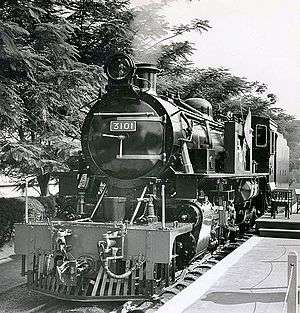EAR 31 class
East African Railways 31 class|

3101 at its naming ceremony |
| Type and origin |
|---|
| Power type |
Steam |
|---|
| Builder |
Vulcan Foundry |
|---|
| Serial number |
6228–6273 |
|---|
| Build date |
1955 |
|---|
| Total produced |
46 |
|---|
|
| Specifications |
|---|
| Configuration |
2-8-4 |
|---|
| UIC class |
1′D2' h2 |
|---|
| Gauge |
1,000 mm (3 ft 3 3⁄8 in) |
|---|
| Driver dia. |
48 in (1,219 mm) |
|---|
| Adhesive weight |
45 long tons (46 t) |
|---|
| Loco weight |
70.2 long tons (71.3 t) |
|---|
| Fuel type |
Oil |
|---|
| Fuel capacity |
1,667 imp gal (7,580 l; 2,002 US gal) |
|---|
| Water cap |
4,108 imp gal (18,680 l; 4,934 US gal) |
|---|
Firebox:
• Firegrate area |
30 sq ft (2.79 m2) |
|---|
| Boiler pressure |
200 psi (1.38 MPa) |
|---|
| Heating surface |
1,963 sq ft (182.4 m2) |
|---|
| • Tubes |
1,511 sq ft (140.4 m2) |
|---|
| • Firebox |
124 sq ft (11.5 m2) |
|---|
Superheater:
|
|
|---|
| • Type |
Inside |
|---|
| • Heating area |
328 sq ft (30.5 m2) |
|---|
| Cylinders |
2 |
|---|
| Cylinder size |
17 in × 26 in (432 mm × 660 mm) |
|---|
| Valve gear |
Walschaerts |
|---|
| Loco brake |
Westinghouse type |
|---|
| Train brakes |
Westinghouse type |
|---|
|
|
|
|
|
|
[2] |
The EAR 31 class was a class of oil-burning 1,000 mm (3 ft 3 3⁄8 in) gauge 2-8-4 steam locomotives. The 46 members of the class were built in 1955 by Vulcan Foundry, in Newton-le-Willows, Lancashire (now part of Merseyside), England, for the East African Railways (EAR). They were a lighter, branch-line version of the EAR 30 class, and worked from various sheds throughout the EAR system.
Class list
The numbers and names of each member of the class were as follows:
See also
References
Notes
Bibliography
- Durrant, A E; Lewis, C P; Jorgensen, A A (1981). Steam in Africa. London: Hamlyn. ISBN 0600349462.
- Patience, Kevin (1976). Steam in East Africa: a pictorial history of the railways in East Africa, 1893-1976. Nairobi: Heinemann Educational Books (E.A.) Ltd. OCLC 3781370.
- Ramaer, Roel (1974). Steam Locomotives of the East African Railways. David & Charles Locomotive Studies. Newton Abbot, Devon, UK; North Pomfret, Vt, USA: David & Charles. ISBN 0715364375.
- Ramaer, Roel (2009). Gari la Moshi: Steam Locomotives of the East African Railways. Malmö, Sweden: Stenvalls. ISBN 9789172661721.
- Staff writer (October 1955). ""31" Class Locomotives". East African Railways and Harbours Magazine. East African Railways and Harbours. 2 (5): 164. Retrieved 8 December 2014.
External links
 Media related to EAR 31 class at Wikimedia Commons
Media related to EAR 31 class at Wikimedia Commons
![]() Media related to EAR 31 class at Wikimedia Commons
Media related to EAR 31 class at Wikimedia Commons